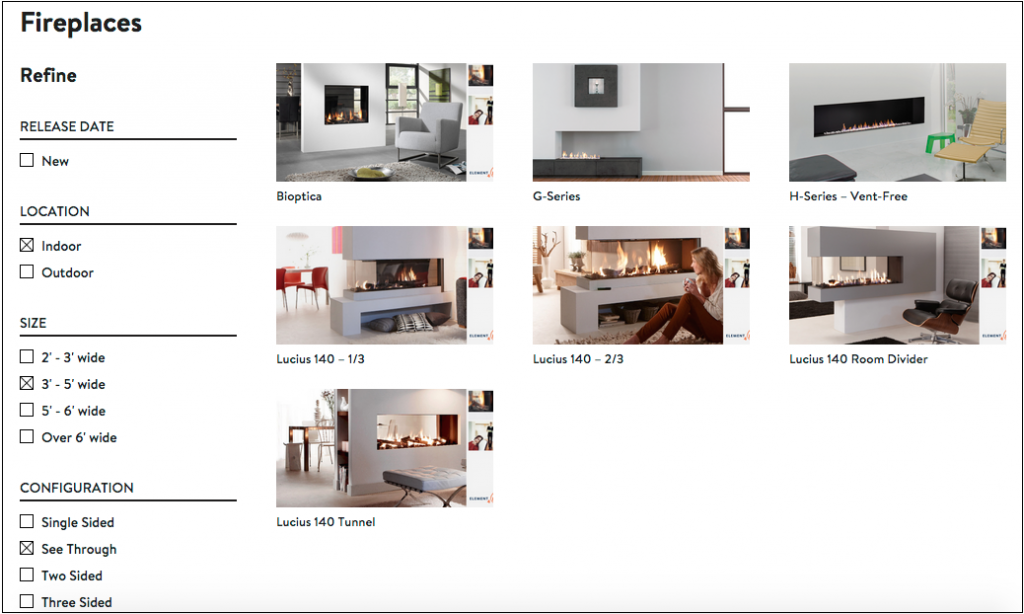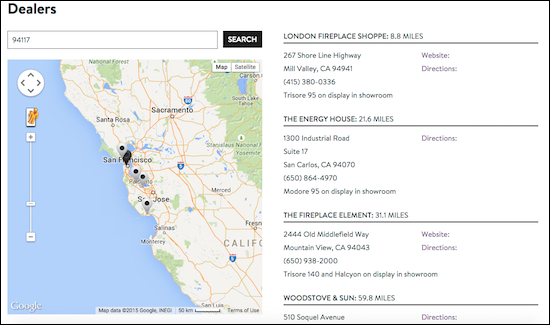When I (Dianna Huff) walked into the offices of European Home, Kevin, the first person to greet me, stood up and shook my hand.
“Thank you,” he said with enthusiasm. “Thank you so much. We love our website. You did a great job!”
The response was the same each time Holly Markham, CEO, introduced me to one of her team members.
“Thank you!”
“The website is wonderful! It’s so easy to use.”
“You and Rachel did a great job. The website makes my job so much easier!”
That last one stopped me. Easier? How was a website making someone’s job easier? That was one I hadn’t heard before.
“We want to eliminate telling people to click the ‘back’ button”
When Holly first called, she was considering having her website completely redesigned because it hindered the company during the sales process.
A manufacturer and distributor of high-end, modern gas fireplaces, European Home sells through fireplace retailers across the U.S. When architects, contractors, and homeowners called, they were on the website and had questions about fireplace specifications and other details.
Holly and her team often found themselves giving detailed instructions on how to find this information. Due to poor navigation, people had to click the back button a lot — a process which was frustrating to Holly and her team and to prospects and customers as well.
To fix the problem, Holly had added a secondary menu navigation, but this only added to the confusion.
As we began work on the redesign, it became apparent pretty fast that the project wasn’t so much a redesign as it was content organization project. Each fireplace — and there were 30 of them — had various attributes (configuration, size, gas type, vent, brand, etc.) plus the attendant specifications, product information, fire media photos, etc.
How could the content be organized so that people could easily find what they were looking for? Rachel spent a lot of time on the backend with our developer, Stephen Merriman.
While the front-side of the new website is stunning, it’s the back-end that’s even more impressive. Stephen made it so that anyone on the European Home team could upload a new fireplace and all the information associated with it. Click, click, click — adding files, images, PDFs, etc. is quick and easy.
Equally impressive, Stephen made it so that people at European Home could categorize each fireplace by size, type, vent, etc. Customers on the front end check boxes with the same labels; with each narrowing down of options, the number of fireplaces presented narrows too.

This custom back-end replaced the WooCommerce theme that the old site was built on and which had caused so much difficultly for Holly and her crew.
The new website makes it easer for European Home to sell products
During my visit, I watched Kevin as he talked with a potential customer on the phone. As he spoke, he directed the customer to various fireplace units on the website.
A simple click here and a click there and the information he and the prospect needed was instantly available.
Everything flowed smoothly and effortlessly.
My jaw dropped. I knew the new website was lovely and easy to use, but this was the first time I had seen a customer use a website in day-to-day operations.
When he got off the phone, he said, “What’s really great is that now we can better work with our showroom folks and that’s helping us connect with retailers we might not otherwise.”
On the old website, people had to click a Google map to find available showrooms within a specified radius. It was quite cumbersome to use — even on a desktop.
With the new website, people simply type in their zip code and get a listing of showrooms and the units on display.

Said Kevin, “If a showroom isn’t located near them, they get a message that tells them to call us as we have listings of showrooms that aren’t displaying our products but do resell them. We then direct people to the showroom and shoot an email to the retailer. It’s a win-win-win.”
When I left the office to have lunch with Holly, I was feeling a little teary and overwhelmed.
My goal is always to help customers solve their challenges and grow their businesses through marketing. Seeing the European Home staff using the website as a daily part of their business — and finding it a joy to use — blew me away.
It also made me completely revise my own view of what exactly a website can do for a business.
A strategically designed website should tie into your business processes
Since this visit with European Home, I have a different perspective when talking to new clients about their marketing and their business. I want to know, what are their challenges and how can the website help solve them?
Recently, for example, I met with a client’s team consisting of engineers, office staff and others. One of the people who spent the most time on the phone with customers said, “We need help educating buyers. I hear the same questions repeatedly.”
Another person on the team explained that due to the critical nature of their product, they needed help communicating with the shipping and receiving guys when they opened the product. Could the website help solve problems they were encountering?
For over an hour I sat and listened to the challenges people were facing and their ideas. I asked my own questions and took lots of notes — all the while my insides jumping with excitement.
I can see now, so clearly, that viewing a website from outdated ideas I absorbed years ago limited me as to how a website could help clients improve sales and their own internal processes.
Since completing the European Home website, Rachel and I have been talking through what I need to ask my small manufacturing clients regarding their websites.
Some of the questions I ask are pretty standard:
- Do you have a logo?
- Which branding elements should we use?
- Is your existing website currently in WordPress?
- Will you require translations?
- Do we need to tie into a back-end CRM or marketing automation platform?
But now I’m asking lots of new ones:
- How do people contact you and why?
- Why can cause a sale to stall and why?
- What information do you find yourself repeatedly sending to customers or prospects?
- What challenges do you have with your existing website?
My goal is to help improve customers’ internal processes — and thus sales — just as they’re continually improving their own manufacturing processes.
I’m finding that the more I unshackle myself from the linear (and limiting) view of copy imposed by a Word doc, and the more I consider a website from a communications and business perspective (versus a “pretty” design), the more creative I’ve become with regard to finding solutions.
A website, as I’m forever saying, isn’t a brochure.
A well-designed, well-thought out website is a business asset. But it’s much more than that, too.
A website can and should help a company increase sales, educate prospects, and improve customer service. If it’s created with a thoughtful strategy and the client in mind, it should also make people’s jobs easier and improve productivity.
If I can have all my clients tell me how much their website has improved their lives and their businesses, then I’ve done my job.
And while it may sound a little corny, my heart will be overflowing with joy, much as it was the day I walked out of the European Home office.
Post Script: Holly Markham hired Rachel Cunliffe and Stephen Merriman to completely redesign the website in 2018. The new site allowed retail fireplace stores to create and download quotes. It was a huge project that required a great deal of “hard thinking,” as Rachel likes to say. The marketing and copy were completed the European Home’s Director of Marketing.
View the European Home website.
Filed under: Our Thinking

Dianna Huff
Thank you! I have learned so much from you. 🙂
Dianna Huff
It depends on the client. Some companies have a designer and I’ll work with that person. Others don’t have anyone, so I always recommend my colleague, Rachel Cunliffe, and her brother Stephen Merriman.
I don’t do web design. Instead I do all the strategy, messaging, positioning, project management, SEO and content.
Thanks for the nice words about my blog. 🙂